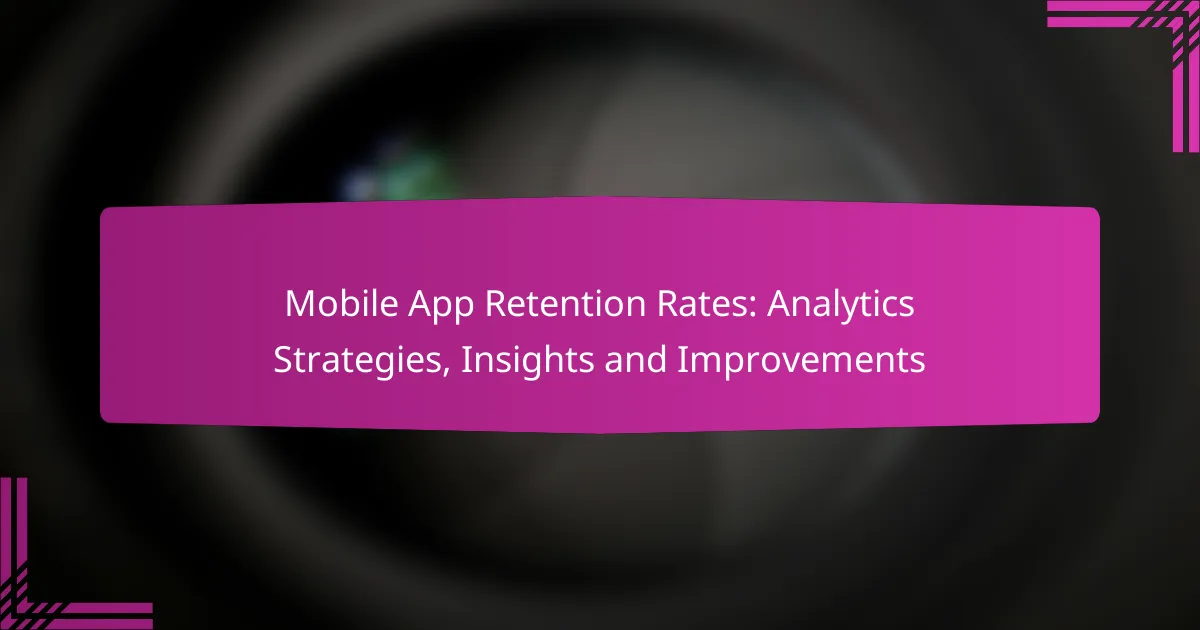A/B testing is a crucial method in mobile app analytics, enabling developers to evaluate different app feature versions to identify which one resonates best with users. By leveraging data-driven insights from user engagement and conversion metrics, A/B testing can significantly enhance user experiences and contribute to the overall success of an app.
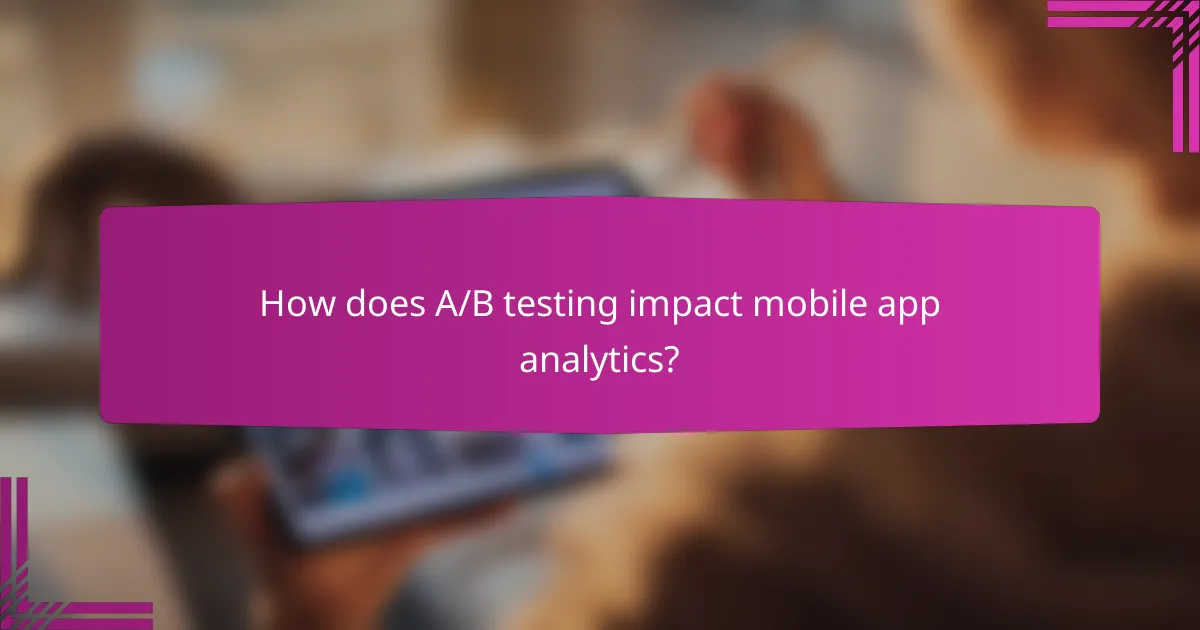
How does A/B testing impact mobile app analytics?
A/B testing significantly influences mobile app analytics by allowing developers to compare different versions of app features to determine which performs better. This method provides data-driven insights that can lead to improved user experiences and increased app success.
Improves user engagement
A/B testing enhances user engagement by identifying which app features resonate most with users. For instance, testing different layouts or content can reveal preferences that lead to longer session times and more interactions.
To effectively improve engagement, focus on testing elements such as push notifications, onboarding processes, or in-app messaging. Small changes can yield substantial increases in user activity, often in the range of 10-30% more interactions.
Increases conversion rates
Implementing A/B testing can lead to higher conversion rates by optimizing critical user actions, such as purchases or sign-ups. By testing variations of call-to-action buttons or promotional offers, developers can determine which versions drive more conversions.
Consider testing different pricing strategies or user flows. Even minor adjustments can result in conversion rate improvements of 5-15%, significantly impacting overall revenue.
Enhances user retention
A/B testing contributes to better user retention by allowing developers to refine features that keep users coming back. By analyzing which app updates or functionalities lead to higher retention rates, teams can focus on what truly matters to their audience.
For example, testing different loyalty programs or personalized content can help identify the most effective strategies for retaining users. Retention improvements of 10-20% are common when implementing data-driven changes based on A/B testing results.
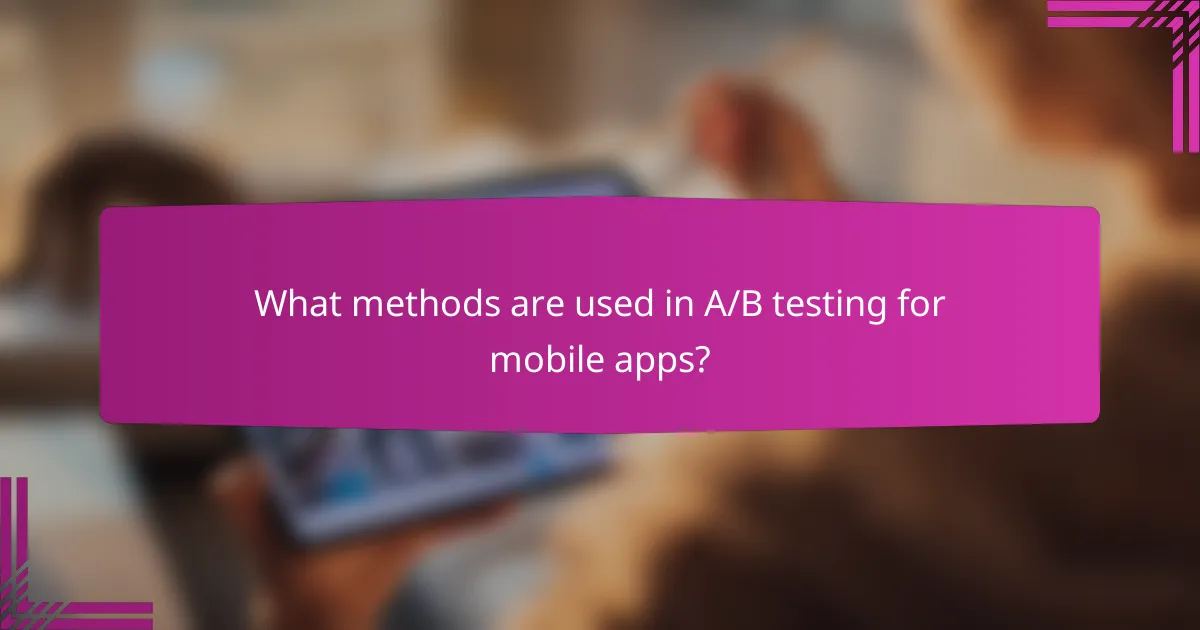
What methods are used in A/B testing for mobile apps?
A/B testing for mobile apps typically involves comparing two or more versions of an app to determine which one performs better based on user engagement, conversion rates, or other key metrics. The main methods include split URL testing, multivariate testing, and sequential testing, each offering unique advantages and considerations.
Split URL testing
Split URL testing involves creating different versions of a webpage or app that are hosted on separate URLs. Users are randomly directed to one of these URLs, allowing for a direct comparison of performance metrics such as click-through rates or time spent in the app. This method is particularly useful for testing major changes, as it can isolate the effects of specific modifications.
When implementing split URL testing, ensure that the sample size is large enough to yield statistically significant results. A common pitfall is not accounting for external factors that may influence user behavior during the test period.
Multivariate testing
Multivariate testing allows for the simultaneous testing of multiple variables to see how they interact with each other. Instead of comparing two versions, this method tests various combinations of elements, such as button colors, text, and images, to identify the most effective combination. This approach can provide deeper insights but requires a larger sample size to achieve reliable results.
To effectively use multivariate testing, prioritize the elements that are most likely to impact user experience. Avoid testing too many variables at once, as this can complicate the analysis and obscure clear results.
Sequential testing
Sequential testing is a method where tests are conducted in a series rather than simultaneously. This approach allows for adjustments based on interim results, making it possible to optimize the app progressively. Sequential testing can be beneficial when resources are limited or when rapid iterations are needed.
When using sequential testing, establish clear criteria for stopping or continuing tests based on performance metrics. Be cautious of biases that may arise from testing over time, as user behavior can change due to external factors or seasonal trends.
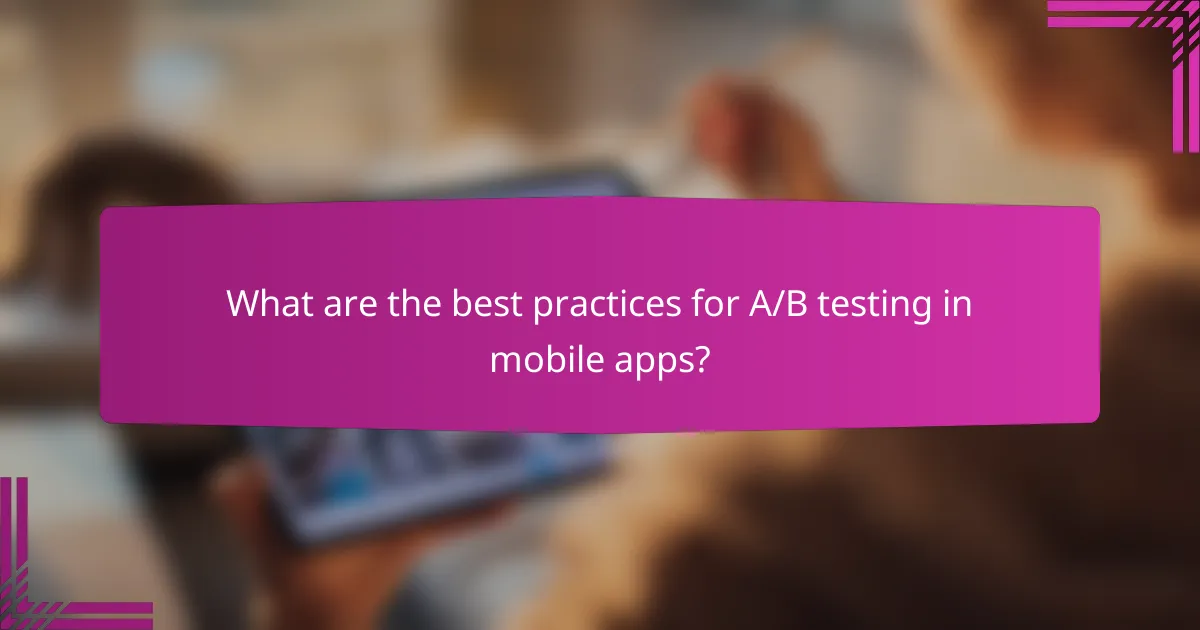
What are the best practices for A/B testing in mobile apps?
Best practices for A/B testing in mobile apps involve setting clear goals, understanding your audience, and utilizing effective analytics tools. These strategies help ensure that tests yield actionable insights and drive meaningful improvements in user experience and engagement.
Define clear objectives
Defining clear objectives is crucial for successful A/B testing in mobile apps. Start by identifying specific metrics you want to improve, such as user retention, conversion rates, or in-app purchases. Having well-defined goals allows you to focus your testing efforts and measure the impact accurately.
For example, if your objective is to increase user engagement, you might test different onboarding processes to see which one keeps users active longer. Ensure that your objectives are measurable and relevant to your overall business goals.
Segment your audience
Segmenting your audience allows for more targeted A/B testing, leading to more relevant results. Consider factors such as demographics, user behavior, and device types when creating segments. This approach helps you understand how different groups respond to changes in your app.
For instance, you might find that younger users prefer a more gamified onboarding experience, while older users favor a straightforward tutorial. Tailoring your tests to specific segments can enhance user satisfaction and improve conversion rates.
Use reliable analytics tools
Utilizing reliable analytics tools is essential for tracking the performance of your A/B tests. Choose tools that provide comprehensive data on user interactions, conversion rates, and other key performance indicators. Popular options include Google Analytics, Mixpanel, and Firebase Analytics.
These tools can help you analyze results effectively and make data-driven decisions. Ensure that the analytics solution you choose integrates well with your app and provides real-time insights to facilitate timely adjustments to your strategies.
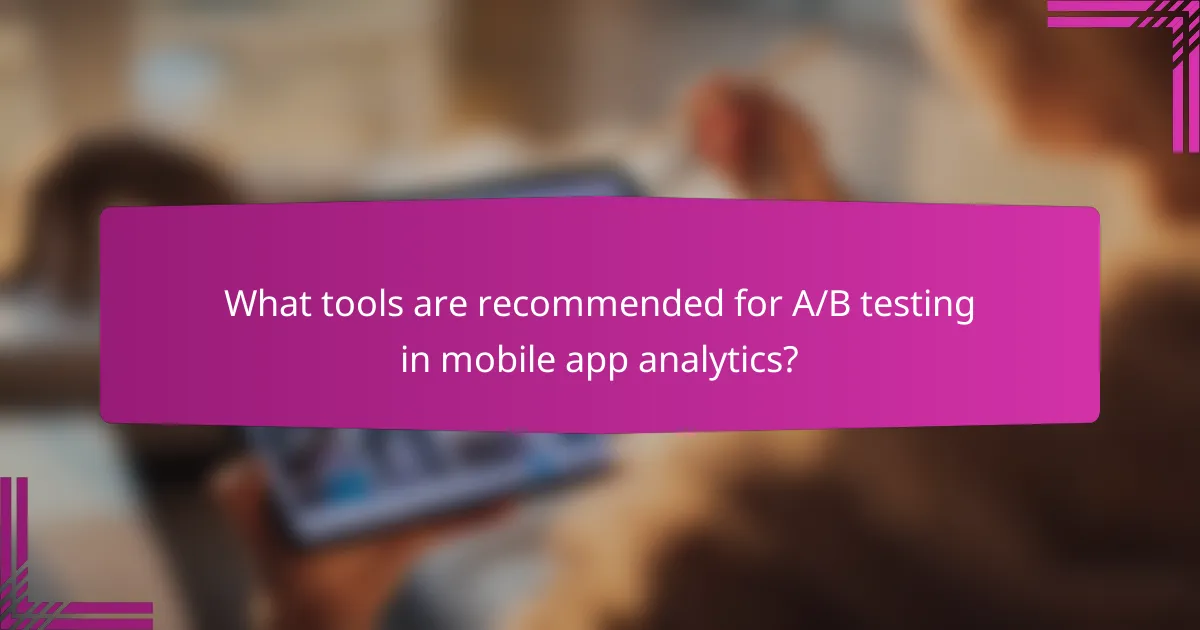
What tools are recommended for A/B testing in mobile app analytics?
Several tools are highly recommended for A/B testing in mobile app analytics, each offering unique features to enhance user experience and optimize app performance. Key options include Optimizely, Firebase A/B Testing, and VWO, which cater to different needs and technical capabilities.
Optimizely
Optimizely is a robust platform that allows developers to run A/B tests seamlessly across mobile apps. It offers a user-friendly interface and powerful analytics tools, making it easy to track user interactions and measure the impact of changes.
One of its standout features is the ability to test multiple variations simultaneously, which can significantly speed up the optimization process. However, users should be aware of the pricing structure, which can be on the higher side for smaller teams.
Firebase A/B Testing
Firebase A/B Testing is integrated within the Firebase suite, providing a straightforward way to conduct experiments on mobile applications. It allows developers to test different app features and configurations, leveraging Firebase’s extensive analytics capabilities to measure results effectively.
This tool is particularly advantageous for teams already using Firebase for app development, as it simplifies the implementation process. Additionally, it supports remote configuration, enabling real-time updates without requiring app redeployment.
VWO
VWO (Visual Website Optimizer) is primarily known for web A/B testing but also offers mobile app testing capabilities. It provides a comprehensive suite of tools for tracking user behavior and optimizing app performance through experimentation.
VWO’s visual editor allows users to create variations without extensive coding knowledge, making it accessible for marketers and product managers. However, it may require additional setup for mobile-specific features compared to dedicated mobile testing tools.
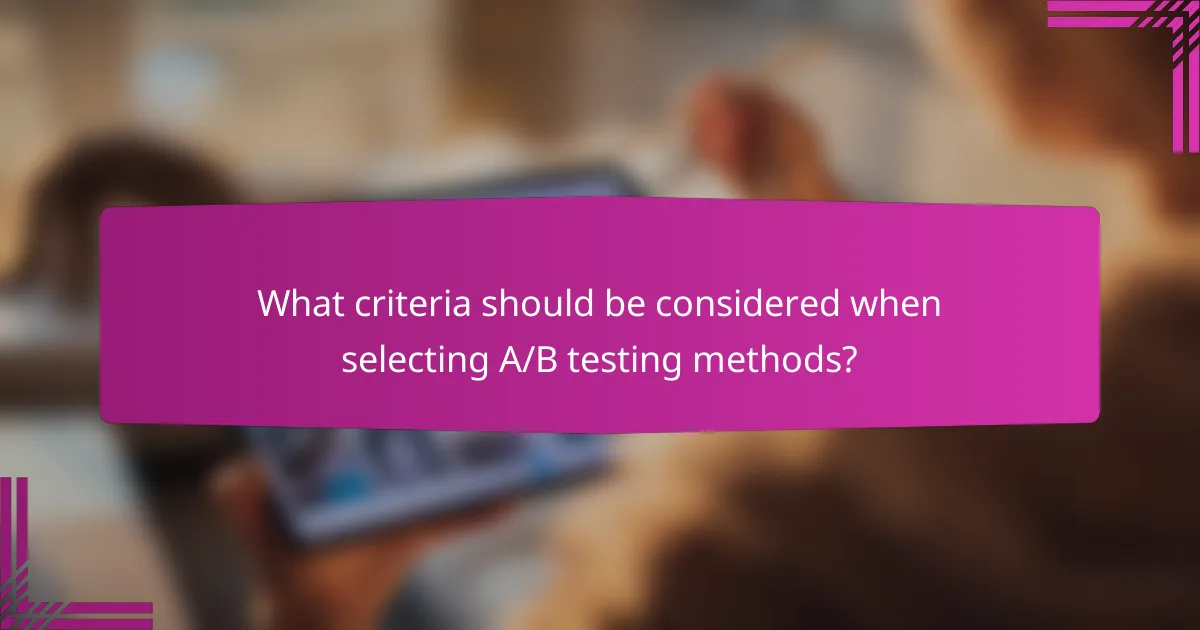
What criteria should be considered when selecting A/B testing methods?
When selecting A/B testing methods for mobile app analytics, consider factors such as your target audience characteristics, the type of app features being tested, and the duration of the tests. These criteria will help ensure that the testing is relevant, effective, and yields actionable insights.
Target audience characteristics
Understanding your target audience is crucial for effective A/B testing. Different demographics may respond variably to changes in app features or design. For example, younger users might prefer more interactive elements, while older users may favor simplicity and ease of use.
Segment your audience based on factors like age, location, and usage patterns. This segmentation allows you to tailor tests to specific groups, increasing the likelihood of meaningful results. Always consider cultural nuances that may affect user behavior.
Type of app features
The features you choose to test can significantly impact your A/B testing outcomes. Focus on elements that directly influence user engagement, such as user interface changes, onboarding processes, or pricing strategies. For instance, testing different call-to-action buttons can reveal which design drives more conversions.
Prioritize features that align with your app’s goals. If your aim is to increase user retention, consider testing variations in notification settings or content recommendations. Always ensure that the features being tested are relevant to your overall app strategy.
Testing duration
The duration of your A/B tests is critical for obtaining reliable results. A common practice is to run tests for at least one to two weeks to account for variations in user behavior over time. This timeframe allows you to gather sufficient data across different days and user interactions.
Avoid rushing the testing process; premature conclusions can lead to misguided decisions. Monitor key metrics continuously during the test period, and be prepared to extend the duration if the results are inconclusive. Aim for a balance between timely insights and statistical significance.
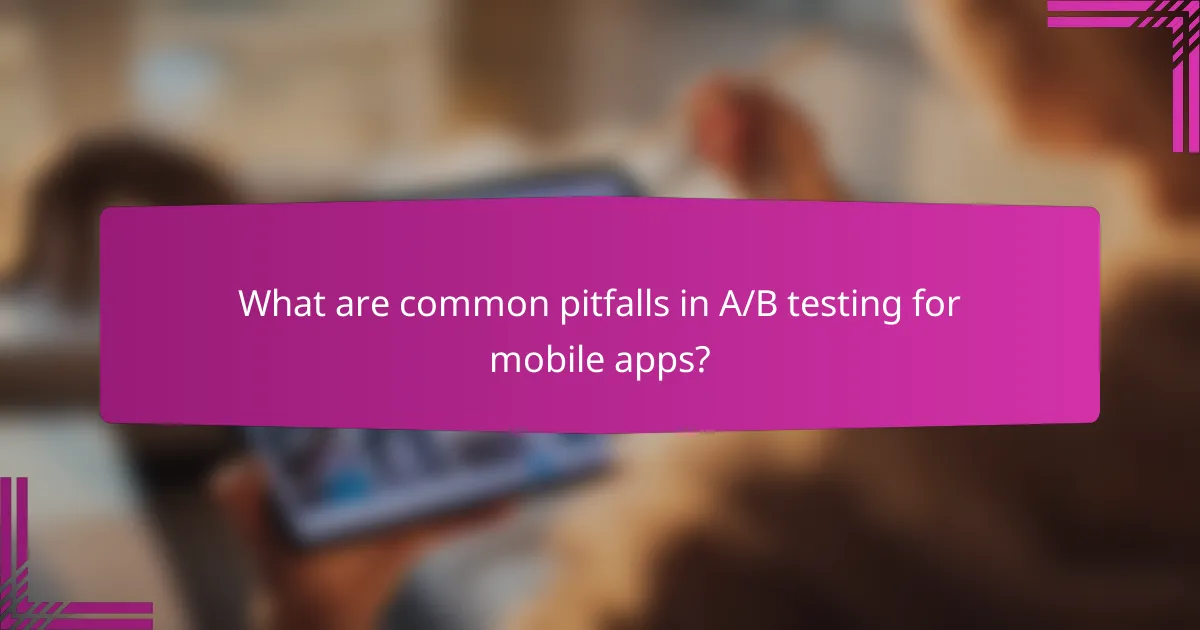
What are common pitfalls in A/B testing for mobile apps?
Common pitfalls in A/B testing for mobile apps include insufficient sample sizes, lack of clear objectives, and not accounting for external factors. These issues can lead to misleading results and ineffective decision-making, ultimately hindering app performance.
Insufficient sample size
Insufficient sample size is a frequent issue in A/B testing that can skew results. When the number of users participating in the test is too low, the data may not accurately represent the broader user base, leading to unreliable conclusions.
A general rule of thumb is to aim for a sample size that allows for statistical significance, often in the range of hundreds to thousands of users, depending on the app’s total user base. Tools and calculators are available to help determine the necessary sample size based on expected conversion rates and desired confidence levels.
To avoid this pitfall, ensure that your test runs long enough to gather adequate data and consider segmenting users to achieve a more representative sample. Regularly monitor the test’s progress and be prepared to adjust the sample size if initial results appear inconclusive.
